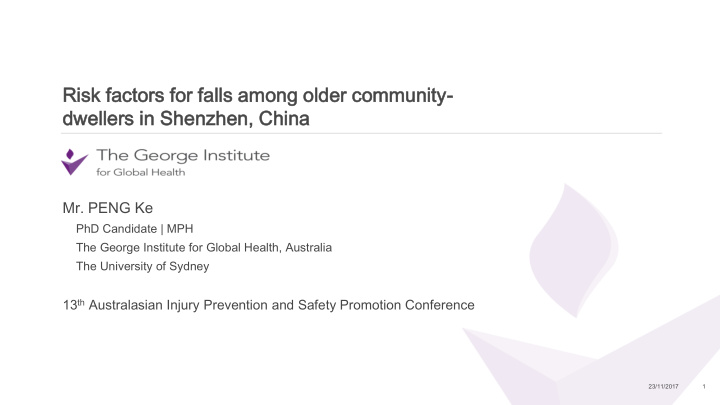



Risk isk factors tors for falls ls amon ong g olde der r community ommunity- dweller ellers s in Shenzhen nzhen, , China ina Mr. PENG Ke PhD Candidate | MPH The George Institute for Global Health, Australia The University of Sydney 13 th Australasian Injury Prevention and Safety Promotion Conference 23/11/2017 1
Shen enzhen zhen city ty • First tier city (Shenzhen, Beijing, Shanghai, Guangzhou) • Urban development level, Economic, Talent attraction and etc.
Key y Messages ssages • What is already known? The risk factors for being a faller or recurrent fallers among older Chinese people have been determined in previous studies. • What this study adds? A history of falls (prior to the past 12 months), presence of at least one chronic disease, walking aid use and living alone were associated with an increased number of falls in older Chinese people. 23/11/2017 3
Backgrou ckground nd and d Objective jective • Approximately 30% of American people aged 65 and over fall annually and around half of these people fall multiple times • The incidence of falls is relatively lower among older Chinese • Risk factors for falls were reported to be similar in older Chinese and Caucasian in previous studies • To determine the number of falls experienced by older community- dwellers in Shenzhen, China • To identify related factors associated with number of falls 23/11/2017 4
Metho thod • Cross -sectional study Multistage random sampling Community-dwellers aged 60 and over Independent ambulation (With walking aids) • Data collection Face to face interview by trained health workers using study-specific questionnaire • Statistical analysis Descriptive analysis Negative binomial regression model 23/11/2017 5
Res esult ult • 1290 (98.5%) of 1310 participants responded • 138 (10.7%) people had at least one fall in the past year • 111 people fell once, 17 people fell twice, 10 people fell at least three times (9 fell 3 times and 1 fell 5 times) 23/11/2017 6
Univ ivariate ariate analy lysi sis Table 2. Factors associated with number of falls in the univariate analysis, number (%) unless otherwise indicated Characteristic 0 fall 1 fall 2 falls ≥ 3 falls IRR 95% CI p-value (n=1152) (n=111) (n=17) (n=10) Female gender 644 (50%) 83 (6%) 9 (0.7%) 4 (0.3%) 1.35 0.94-1.95 0.1 Age, mean (SD)* 68.2 (6.5) 68.0 (6.5) 69.2 (6.5) 70.7 (6.5) 73.2 (6.2) 1.04 1.02-1.07 0.01 Education illiteracy 69 (5%) 12 (0.9%) 0 0 1.08 0.60-1.57 0.70 primary 195 (15%) 22 (2%) 2 (0.2%) 1 (0.1%) Middle 296 (23%) 20 (2%) 3 (0.2%) 1 (0.1%) High 310 (24%) 27 (2%) 8 (0.6%) 2 (0.2%) College+ 283 (22%) 30 (2%) 4 (0.3%) 5 (0.4%) Living alone* 24 (2%) 5 (0.4%) 3 (0.2%) 0 2.64 1.12-6.22 0.03 Chronic disease* 808 (63%) 93 (7%) 16 (1%) 9 (0.7%) 2.60 1.60-4.21 < 0.01 < 0.01 Medication usage* 580 (45%) 69 (5%) 13 (1%) 6 (0.5%) 1.70 1.18-2.44 Visual 383 (30%) 54 (4%) 8 (0.6%) 4 (0.3%) 1.65 1.16-2.36 0.01 impairment* Hearing loss 173 (13%) 24 (2%) 3 (0.2%) 2 (0.2%) 1.39 0.89-2.19 0.15 Poor subjective 370 (29%) 58 (5%) 11 (0.9%) 6 (0.5%) 2.42 1.70-3.43 < 0.01 body sense perception* Low mood* 276 (21%) 35 (3%) 6 (0.5%) 5 (0.4%) 1.65 1.13-2.41 0.01 < 0.01 Walking aid use* 29 (2%) 10 (0.8%) 3 (0.2%) 4 (0.3%) 5.15 2.84-9.36 Nocturia 267 (21%) 29 (2%) 6 (0.5%) 4 (0.3%) 1.40 0.94-2.07 0.10 Poor self-rated 700 (54%) 82 (6%) 12 (0.9%) 7 (0.5%) 1.62 1.10-2.37 0.01 health * Fall history* 96 (7%) 83 (6%) 13 (1%) 9 (0.7%) 18.89 13.23-26.98 < 0.01 Balance ability, 1.74 (3.6) 1.51 (3.2) 3.50 (5.5) 3.76 (6.4) 5.70 (4.19) 1.11 1.07-1.15 < 0.01 mean (SD)* Note. College+ is at college level and above.
Multi ltivariate variate analy alysi sis Table 3. The result of multivariate negative binomial regression Variable IRR 95%CI p-value Chronic disease 1.85 1.09-3.19 0.02 < 0.01 Fall history 16.51 11.37-23.99 Table 4. Variables retained in the multivariate negative binomial regression model with fall history removed Variable IRR 95%CI p-value Living alone 2.46 1.11-5.46 0.03 Chronic disease 1.85 1.05-3.26 0.04 Walking aids use 2.26 1.10-4.66 0.03 Impaired balance 1.05 0.99-1.10 0.06
Disc iscuss ussion ion Risk factors Our study Morris et al. Shi et al. (Recurrent (Number of falls) (Multiple falls) falls) × × Fall history √ × Chronic disease √ √ × × Living alone √ × Walking aids use/ √ √ poor mobility × Visual impairment √ √ × ( p=0.06 ) × impaired balance √ • Strength: High respondent rate, Randomly selected participants • Limitation: Recall bias 23/11/2017 9
Conclusi nclusion on • The factors associated with number of falls in the past year were: Falls history The presence of at least one chronic disease Walking aid use Living alone 23/11/2017 10
Reference ference Kwan, M.M.S., Close, J.C., Wong, A.K.W. and Lord, S.R., 2011. Falls incidence, risk factors, and consequences in Chinese older people: a systematic review. Journal of the American Geriatrics Society , 59 (3), pp.536-543. Morris, M., Osborne, D., Hill, K., Kendig, H., Lundgren-Lindquist, B., Browning, C. and Reid, J., 2004. Predisposing factors for occasional and multiple falls in older Australians who live at home. Australian journal of physiotherapy , 50 (3), pp.153-159. Jing, S.H.I., ZHOU, B.Y., TAO, Y.K., YU, P.L., ZHANG, C.F., QIN, Z.H. and SUN, Z.Q., 2014. Incidence and associated factors for single and recurrent falls among the elderly in an urban community of Beijing. Biomedical and Environmental Sciences , 27 (12), pp.939-949.
Ackno nowledg wledge • Co -authors: Prof Cathie Sherrington A/Prof Anne Tiedemann Dr. Haibin Zhou Prof Ji Peng • Affiliated institutes: The School of Public Health, The University of Sydney, Sydney, Australia Shenzhen Center for Chronic Disease Prevention and Control, Shenzhen, China The George Institute for Global Health, UNSW, Sydney, Australia 23/11/2017 12
Than ank k you! u! Any y Ques estions? tions? • Email: kpeng@georgeinstitute.org.au • Research of interest: Falls and fall-related injuries (mainly hip fracture) 23/11/2017 13
Recommend
More recommend